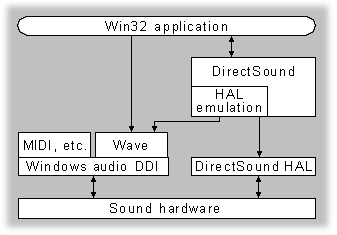
The following illustration shows the relationships between DirectSound and other system audio components.

DirectSound and the standard Windows waveform-audio functions provide alternative paths to the waveform-audio portion of the sound hardware. A single device provides access from one path at a time. If a waveform-audio driver has allocated a device, an attempt to allocate that same device by using DirectSound will fail. Similarly, if a DirectSound driver has allocated a device, an attempt to allocate the device by using the waveform-audio driver will fail.
If two sound devices are installed in the system, your application can access each device independently through either DirectSound or the waveform-audio functions.
Note Microsoft Video for Windows currently uses the waveform-audio functions to play the audio track of an audio visual interleaved (.avi) file. Therefore, if your application is using DirectSound and you play an .avi file, the audio track will not be audible. Similarly, if you play an .avi file and attempt to create a DirectSound object, the creation function will return an error.
For now, applications can release the DirectSound object by calling IDirectSound::Release before playing an .avi file. Applications can then re-create and reinitialize the DirectSound object and its DirectSoundBuffer objects when the video finishes playing.